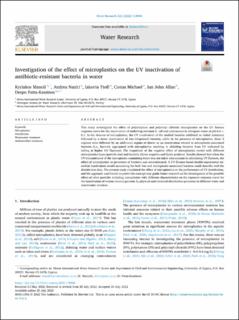| dc.contributor.author | Manoli, Kyriakos | |
| dc.contributor.author | Naziri, Andrea | |
| dc.contributor.author | Ttofi, Iakovia | |
| dc.contributor.author | Michael, Costas | |
| dc.contributor.author | Allan, Ian | |
| dc.contributor.author | Fatta-Kassinos, Despo | |
| dc.date.accessioned | 2022-10-25T05:46:31Z | |
| dc.date.available | 2022-10-25T05:46:31Z | |
| dc.date.created | 2022-10-18T15:39:58Z | |
| dc.date.issued | 2022 | |
| dc.identifier.citation | Water Research. 2022, 222, 118906. | en_US |
| dc.identifier.issn | 0043-1354 | |
| dc.identifier.uri | https://hdl.handle.net/11250/3028060 | |
| dc.description.abstract | This study investigated the effect of polyethylene and polyvinyl chloride microplastics on the UV fluence response curve for the inactivation of multidrug-resistant E. coli and enterococci in ultrapure water at pH 6.0 ± 0.1. In the absence of microplastics, the UV inactivation of the studied bacteria exhibited an initial resistance followed by a faster inactivation of free (dispersed) bacteria, while in the presence of microplastics, these 2 regimes were followed by an additional regime of slower or no inactivation related to microplastic-associated bacteria (i.e., bacteria aggregated with microplastics resulting in shielding bacteria from UV indicated by tailing at higher UV fluences). The magnitude of the negative effect of microplastics varied with different microplastics (type/particle size) and bacteria (Gram-negative and Gram-positive). Results showed that when the UV transmittance of the microplastic-containing water was not taken into account in calculating UV fluences, the effect of microplastics as protectors of bacteria was overestimated. A UV fluence-based double-exponential microbial inactivation model accounting for both free and microplastic-associated bacteria could describe well the disinfection data. The present study elucidated the effect of microplastics on the performance of UV disinfection, and the approach used herein to prove this concept may guide future research on the investigation of the possible effect of other particles including nanoplastics with different characteristics on the exposure response curve for the inactivation of various microorganisms by physical and chemical disinfection processes in different water and wastewater matrices. | en_US |
| dc.language.iso | eng | en_US |
| dc.publisher | Elsevier | en_US |
| dc.rights | Navngivelse-Ikkekommersiell 4.0 Internasjonal | * |
| dc.rights.uri | http://creativecommons.org/licenses/by-nc/4.0/deed.no | * |
| dc.title | Investigation of the effect of microplastics on the UV inactivation of antibiotic-resistant bacteria in water | en_US |
| dc.type | Peer reviewed | en_US |
| dc.type | Journal article | en_US |
| dc.description.version | publishedVersion | en_US |
| dc.rights.holder | © 2022 The Authors | en_US |
| dc.source.pagenumber | 11 | en_US |
| dc.source.volume | 222 | en_US |
| dc.source.journal | Water Research | en_US |
| dc.identifier.doi | 10.1016/j.watres.2022.118906 | |
| dc.identifier.cristin | 2062482 | |
| dc.source.articlenumber | 118906 | en_US |
| cristin.ispublished | true | |
| cristin.fulltext | original | |
| cristin.qualitycode | 2 | |

